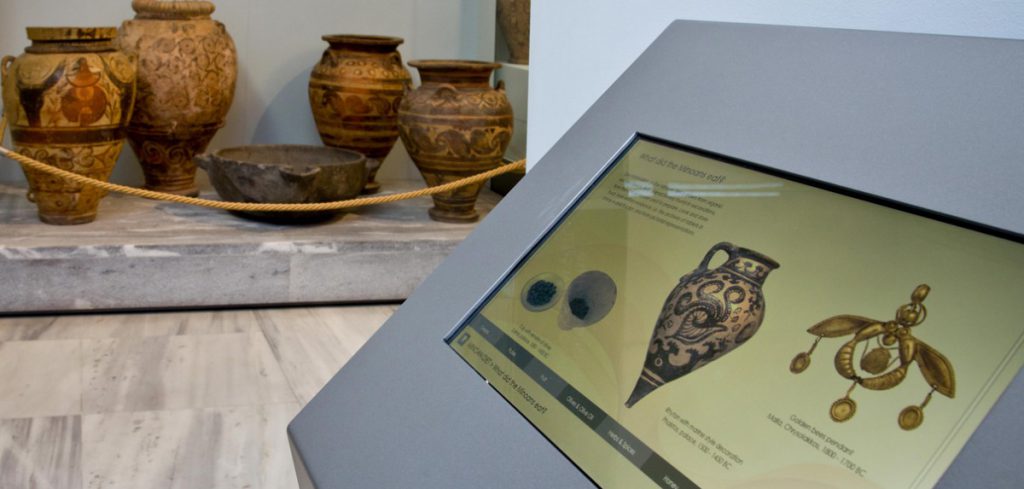The Heraklion Archaeological Museum is one of the oldest and most important museums in Greece, and among the most famous museums in Europe. It houses representative artefacts from all periods of Cretan prehistory and history, covering a chronological span of over 5,500 years from the Neolithic period to Roman times. The Heraklion Archaeological Museum prides itself for its unique Minoan collection, which includes the masterpieces of Minoan art. It is rightly considered as the Museum of Minoan Culture par excellence.
For purposes of the renovation of the exhibition spaces of the Heraklion Archaeological Museum, the Institute of Computer Science of Foundation for Research and Technology – Hellas has installed a variety of innovative interactive systems aiming to deliver interactive and immersive experience through on-site virtual exhibitions.
Seven (7) interactive exhibits are scattered within the Museum and occupy physical spaces where digital technology is used to “accompany” and “explain” physical exhibits and antiquities. The installation of interactive exhibits in the premises of the Archaeological Museum of Heraklion covers the most important thematic categories of the Museum.
These interactive systems are:
- Ami CMS, a web platform that manages Ambient Intelligence applications, enabling users to administer multimedia scenarios and installations
- Infocloud, a system that comprises a collection of keywords, images and video thumbnails displayed on a very large touch screen, presented in a constant flow. Infocloud presents: (i) the Minoan thalassocracy and more specific, the influence of prehistoric Crete in ancient times and the spread of Minoans around Aegean through descriptions of archeological sites and objects with the Minoan influence, as well as reports of the Archeological Secretariat concerning the tradition and the society of Cretans, and (ii) Daedalus & Icarus: The first flight and thereafter.
- Interactive Wall supports games that can be played by one, two or more players simultaneously, using their entire body, comprising a large projection area. The Interactive Wall provides visitors an innovative edutainment experience as they control the game using their “virtual” shadows projected on the display. The “virtual” shadow follows the body movements as users stand in front of the screen. Minoan ancient objects have to be separated according to specific criteria, such as material, usage and date, depending on the difficulty level that the user selects. This interactive game aims to entertain and educate the visitors in a pleasant way while using innovative technologies that offer interaction from distance. Interactive Wall can be played in cooperative or competitive mode.
- Jigsaw Puzzle offers a typical puzzle game functionality providing innovative technologies allowing the interaction from distance. The user is called to select a picture through a variety of Minoan ancient artifacts, as well as the difficulty level in order afterall to fulfil the puzzle’s completion. Jigsaw Puzzle can be played in cooperative or competitive mode.
- Interactive Multimedia Viewer enables the presentation and remote management of multimedia content presents in one or more computers at the same time while using interaction from distance.
- Info Kiosk provides information within categories in the form of augmented digital book, enriched with additional features. Each thematic contains text, image, video clip or even micro-games. Text may comprise hyperlinks which provide further information with related multimedia content through a pop-up window. The info kiosks are user friendly and intuitive interactive systems and provide information about Minoan Diet, Minoan Architecture, Minoan Writing & Sealing and Minoan Technology in prehistoric Crete.
- TimeViewer is a system that allows the modeling, storing, visualization and multimodal interaction with timelines through a 3D view based on a “time tunnel” metaphor, which is suitable to experience the time dimension, as well as enhanced exploration of available information.The information presented by the system is focused on the history of archaeological research and excavations in Crete through the establishment, operation and recent renovation of the Archaeological Museum of Heraklion, emphasizing key chronological stations. The interaction of the system is based on gesture recognition from distance.
- Entrance hall Video Wall presentation
